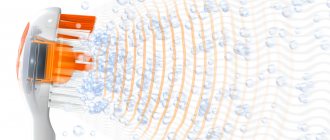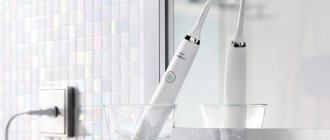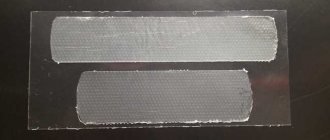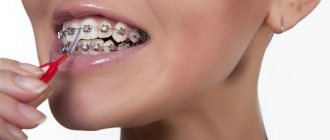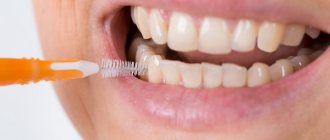The long and interesting history of the toothbrush began thousands of years ago, when various chewing sticks began to be used as brushes.
The brush, which resembled a tuft of bristles on a stick, came to Russia during the time of Ivan the Terrible. Since those distant times, the brush mechanism has undergone considerable changes, and today it is increasingly difficult to choose this item for maintaining oral hygiene, because there are too many brushes, and every year they become more perfect and functional.
All types of toothbrushes today - regular, electric, ionic, ultrasonic, etc.
Once every few months we go to the store (or pharmacy) and are faced with a difficult choice - which brush to choose that is inexpensive, cleans well, and doesn’t “cut” our gums.
And, as a rule, we take the first one we come across at a reasonable price, because “who cares!”
But there is a difference. And not only the cleanliness of the teeth, but also the quality of the enamel, the condition of the gums, etc. will depend on the correct choice of brush.
Therefore, before you go for a brush, study the basic rules of choice.
Choosing toothbrush bristles
The quality, material, length and other characteristics of the bristles of a toothbrush directly determine the effectiveness of oral hygiene.
There is a myth that everything natural is better than artificial. When applied to toothbrush bristles, this is not true. Natural ones have more disadvantages than advantages. They have a porous structure and a median channel in which bacteria accumulate and multiply, and they are also hard and severely scratch the gums. Artificial bristles are smooth, have no pores, dry quickly and are less susceptible to contamination by microorganisms, therefore they are considered safer. Modern materials for toothbrushes are soft and do not damage tooth enamel and gum surfaces when brushing.
The most important characteristic to pay attention to is the stiffness of the bristles. How to choose the right one for yourself?
- Sensitive.
This is a very soft bristle that has the most delicate effect on the oral cavity. This type of toothbrush is recommended for brushing teeth in case of inflammatory periodontal diseases.
- Software
Soft bristles are suitable for cleaning children's teeth, caring for sensitive gums and thin enamel. Dentists often recommend this type of brush for pregnant women and people with diabetes. In these conditions, there is often swelling, soreness of the gums and high vulnerability of the tissues surrounding the tooth, due to hormonal changes.
- Medium.
A medium-hard brush is suitable for the vast majority of people with healthy teeth. It provides a moderately strong effect on teeth and gums, effectively removing plaque without causing pain or discomfort.
- Hard.
The stiff bristles help remove stubborn plaque and are suitable for effective cleaning of removable dentures.
- Extra hard.
Very hard brushes should only be used as prescribed by a dentist, as they increase the risk of injury to the gums and damage to the enamel. This toothbrush is used if you are prone to stone formation.
Many toothbrush manufacturers combine bristles of different hardnesses into one model. For example, the central bristles are made more rigid for high-quality cleaning of chewing surfaces, and the side bristles are made softer for careful removal of dirt along the gum edge.
In addition to the stiffness of the bristles, the degree of processing is important. Most modern brushes have rounded bristles to prevent injury to the gums. Brushes with pointed bristles are less common - they penetrate well into the interdental spaces, but can damage soft tissues.
The types of bristle hardness are as follows:
- Very soft (approx. - ultrasoft, extrasoft, sensitive). Suitable for children under 5 years of age and for adults with very sensitive enamel and gums, stage 1-2 periodontitis, and enamel damage.
- Soft (approx. - soft). Indicated for expectant and nursing mothers, children aged 5-12 years, as well as for diabetes and bleeding gums.
- Average (approx. - medium). The most popular brush for healthy enamel and oral cavity for adults and children over 12 years old.
- Hard and very hard (approx. – hard, extra-hard). An option for adults who are familiar firsthand with the rapid formation of plaque. And also for people using braces and other orthodontic structures.
And now a little about the material from which the brushes are made.
No matter how popular the idea that everything and everywhere is natural, dentists categorically do not recommend brushes with natural bristles.
Are electric brushes harmful to teeth?
When using any new device, it is advisable to first consult a doctor to determine whether it is suitable for your case. An electric toothbrush has a peculiar effect on the surface of the teeth and gums. After research, it was found that the greatest impact is on the root gums. Therefore, it is undesirable to use them if you are prone to bleeding and periodontitis and other diseases. According to scientists, the most gentle and effective of all types is an electric brush with simultaneous rotation and vibration of the head. It outperformed others in terms of relatively low gum inflammation after use.
It is also not recommended to use such brushes if the enamel is weak and thinned, since it can wear off due to intense exposure. For the same reason, it is not recommended to use them daily; 2-3 times a week will be enough. It is also important when brushing not to press hard on the brush, but to touch the surface of the teeth and gums lightly.
And there are several reasons:
- In such brushes, bacteria multiply 2 times faster, and, accordingly, they will also have to be changed more often.
- In addition, the tips of pig bristles (yes, it is from this bristle that brushes labeled “natural” are made) cannot be rounded, and they can significantly injure the gums and the enamel itself.
- It is also worth noting that natural bristles quickly lose their shape and properties - they fluff up and break.
Therefore, the ideal option is nylon bristles and a handle made of safe plastic.
How to choose the right toothbrush
When choosing a toothbrush, it is important to consider the following parameters:
- Hardness level
- Length
- Bristle location
The shape and length of the handle and cleaning surface can be selected to suit individual preferences. You also need to take into account indicators such as age and oral health characteristics. Before choosing a toothbrush, it is better to consult your dentist. After examining the gums, he will recommend the correct shape and rigidity of the device.
The brush should have slightly rounded bristles. This is important for the safety of the gums - sharp straight tufts will injure them. There should be an additional rough surface behind the cleaning head. It will provide additional cleaning of the cheeks and tongue, thereby having a beneficial effect on the overall condition of the oral cavity.
Electric brushes, if there are no contraindications, can be used up to 2 times a week. For the remaining days, it is recommended to use a high-quality simple brush. Here are a few more criteria to pay attention to:
- The bristles should be made from artificial materials. This is due to the fact that natural bristles are overly soft and unhygienic - bacteria easily multiply inside them. In addition, their ends cannot be rounded, which can negatively affect the gums and enamel.
- The hardness of the brush is indicated on the packaging and depends on the diameter of the fiber. When choosing hardness, you need to take into account the age and characteristics of the oral cavity. Soft brushes are indicated for children, as well as people suffering from swelling, bleeding, sore gums, and abrasion of hard tissues. Medium hardness is a universal option. Hard and very hard options cannot be used without a doctor’s prescription
- The size also needs to be selected individually. For daily use, we recommend brushes in which the working part is short and covers 2-2.5 adjacent teeth. For children it is recommended to use a brush with a head of 18-25 mm, for adults - up to 30 mm. These brushes are easy to use and can clean hard-to-reach areas.
Design is important when choosing a toothbrush for children.
It is especially important to pay attention to choosing the right brush for your child. It should be appropriate for his age and also have a beautiful design. To make cleaning convenient for your baby, the brush, its head and handle must have the correct shape and size. For children under two years of age, a brush with silicone bristles, a rubberized head of about 1.5 cm and a handle up to 10 cm in length is best suited. For children under 5 years of age, a soft brush with a head up to 2 cm and handles up to 17 cm is suitable.
Electric brushes are suitable for children aged three years and older. They effectively remove plaque and protect against caries. There are children's versions of electric brushes that have soft and low bristles. They run on batteries, protected by a waterproof case, so they are completely safe for children. It is first important to show your child to the dentist, who will help with the correct choice of brush.
It is important to teach your child how to brush their teeth correctly. He must first do this under the supervision of an adult.
Toothbrush sizes and cleaning head shape – what is important?
- The ideal length of the working section of the brush is simply checked - the brush should capture 2-2.5 teeth. Only then is the maximum cleaning effect achieved for the chewing group of teeth.
- The length of the brush head, which is chosen for children, is 18-25 mm, for fathers and mothers – a maximum of 30 mm.
- No corners - only rounded shapes to reduce the risk of injury to the mucous membrane to a minimum.
- The area where the brush head connects to the handle must be movable so that the “spring effect” reduces pressure on the soft and hard tissues in the mouth.
- As for the handle , it should be thick, fit comfortably in the hand and have special anti-slip inserts.
Choosing a toothbrush: modern models, varieties, selection criteria
There is a huge variety of modern toothbrush models on pharmacy shelves, and this makes it somewhat difficult to choose the right option for yourself. Many are based only on external attractiveness or give preference to the model who appears in commercials more often than others. Today, this hygienic device is embodied in many different modifications and can have a variety of characteristics. Therefore, later in this article we will talk in detail about how to choose a toothbrush for an adult and a child, how hard it should be in your particular case.
Selecting a brush based on the location of the tufts:
- Hygienic : the bundles are even and straight, of the same length. Most often, this option is found among children's brushes.
- Preventive . On these brushes, the tufts can be located in completely different directions and can have different lengths and hardness. There may also be rubber bristles on the sides to massage the gums.
- Special . Option for cleaning plaque from implants, etc. Buy in pharmacies or to order.
Brushes for braces: choosing the optimal brush
When choosing brushes for a braces system, it is important to take into account the individual characteristics of the teeth and gums and their condition. The brushes themselves are different:
- head shape;
- length of bristles;
- stiffness of the bristles;
- handle length.
The shape can be cylindrical or cone-shaped, the latter is suitable for daily use; people with braces need to choose special orthodontic brushes that allow them to remove plaque in all labyrinths of the system.
Short length bristles are suitable for cleaning the side surfaces of teeth, medium length is suitable for implants, crowns and dentures, and long bristles are suitable for people with braces and a problem bite.
The optimal hardness option is medium. Soft and hard are recommended in special cases according to doctor’s indications. The length of the handle is a matter of convenience. You need to select a brush with your dentist; he will first measure the distance between the teeth and, based on this indicator, select a device. If you make the wrong choice, tooth enamel and gums will be damaged.
Conclusion:
The best choice would be a toothbrush with artificial bristles, soft or medium hardness, and a small head size. Electric and ultrasonic brushes make cleaning your teeth easier, but they must be used carefully.
Today, toothbrushes can boast the following features and additions:
- Rubber inserts on the handle so that the brush does not slip out of your hands.
- Rubber relief pad for cleaning the tongue on the back of the head.
- Indicator bristles that change color when it’s time to replace the brush with a new one.
- Multi-level and multi-directional bristles , allowing for maximum effective cleaning of teeth and dental spaces.
- Ribbed surface for gum massage.
- Use of silver ions (double effect).
Classification of electric toothbrushes
Today, electric toothbrushes are gaining popularity and may soon supplant regular manual ones. Their advantage is the high cleaning efficiency, which is possible thanks to the rapid movements and pulsations of the bristles. It is impossible to achieve this effect manually, so electric brushes are better than conventional ones at removing tartar, plaque, and cleaning hard-to-reach areas.
Electric toothbrushes have a built-in motor and a rechargeable battery or battery that allows them to operate autonomously.
Electric brushes, depending on their design and technology, are divided into three main types:
- Rotary.
- Sound.
- Ultrasonic.
The simplest among electric brushes are rotary ones. Their cleaning head rotates at high speed, providing mechanical removal of plaque and food debris from the surface of the teeth. They are accessible to users of any budget and are easy to use, but at the same time clean teeth better than manual brushes.
An example of high-quality rotational models is the B.Well MED-810 or CS Medica CS-465-M.
The operation of sonic brushes is based on more complex technology. The high-frequency generator creates a sound wave that causes the bristles of the cleaning head to pulsate at a high frequency. Thanks to such pulsations, the sonic brush not only removes plaque well, but also creates fine foam with oxygen bubbles in the mouth. By bursting, they remove contaminants in the most difficult areas of the oral cavity. In addition, the sonic brush gently massages the gums, is suitable for caring for braces, implants, and allows you to carefully clean gum pockets. Here are some great models: Panasonic EW-DL82-W820, CS Medica CS-161.
The ultrasonic model is similar to the sound one, the only difference being that it does not generate audible sound vibrations, but high-frequency ultrasound. It effectively destroys even complex pigmented plaque, penetrates hard-to-reach places, has a healing effect on the gums, and increases their permeability to toothpaste components. Popular models of ultrasonic brushes are Megasonex, Donfeel.
It should be taken into account that electric brushes have a number of contraindications and are not suitable for young children, so it is not recommended to use them without first consulting a dentist.
Rules for caring for toothbrushes - how often do you need to replace toothbrushes with new ones?
Like all personal care products, brushes also have their own care rules:
- Each family member has his own brush.
- The brushes of different family members should not touch each other. Either you should use special caps (ventilated!), or a separate cup for each brush. This rule especially applies to children's and adult brushes: they are stored separately!
- It is not recommended to store a wet brush in a closed case - this will cause bacteria to multiply 2 times faster.
- Storing toothbrushes with razors or other similar tools is unacceptable!
- The maximum period for using a toothbrush is 3 months for medium hardness, 1-2 months for soft hardness.
- After each cleaning procedure, the instrument is thoroughly washed (laundry soap is recommended) and then put away to dry in a special glass.
- It is unacceptable for the brush to lie on a wet surface or sit sour in a long-unwashed common glass.
- Once a week, it is recommended to disinfect the brush with a special solution for teeth (note: antibacterial rinse).
- If there was treatment for gingivitis, stomatitis, etc. – the brush should be replaced immediately after recovery.
The site Colady.ru thanks you for your attention to the article - we hope that it was useful to you. Please share your feedback and tips with our readers!
Classification of toothbrushes
Today, the toothbrush market offers a huge range of models that differ in design, cleaning technology, material and other parameters. A clear classification helps to understand this diversity.
The most accurate, complete and modern classification is that of Honored Dentist, Doctor of Medical Sciences, Professor of Medical University and Academician of PANI S.B. Ulitovsky.
According to his classification, brushes are:
- children, teenagers and adults;
- hygienic, preventive and additional;
- manual, electrical and mechanical;
- straight and angular, with and without indication;
- artificial and natural bristles;
- one-, two-, three- and multi-level according to the nature of the arrangement of the beams;
- cut, rounded, polished, ground, combined (according to the degree of bristle processing);
- setron, nylon, perlon, derolon, polyurethane, combined - according to the bristle material;
- very soft, soft, medium hard, hard, very hard, mixed and combined - according to the stiffness of the bristles;
- with flat, narrow, thin, round, combined, mixed, hard and springy handles;
- small, medium and large - depending on the size of the handle;
- with corrugated, flat, concave, convex, horizontal, mixed, circular, vertical, universal, special, combined, mixed and without grip.
It can be difficult to understand such diversity without the help of a dentist, so we recommend consulting with your doctor.
Why don't dentists like bamboo brushes?
One of the green complaints about toothbrushes is that they are made of plastic, which is difficult to recycle. In the wake of interest in ecology, manufacturers began to produce bamboo and wooden brushes, but professionals are quite skeptical about them. The fact is that bamboo and wooden cabinets are quickly exposed to moisture, which is abundant in any bathroom. Mold can (and does) grow unnoticed on the brush, which has a detrimental effect on the body.
Another “ecological” trend is natural bristles, on which, unfortunately, microorganisms that cause caries and other dental diseases accumulate much more quickly. Nylon fibers are much safer for the oral cavity in this regard.
By the way, the tongue also needs to be cleaned of plaque. On the back of many manual brushes there is a ribbed surface designed specifically for “massaging” the tongue. However, if it is not there, the brush itself will also easily cope with this task.
In addition to brushing, don't forget to choose the right toothpaste and other hygiene products, such as mouthwash and dental floss.
Toothbrush Oral-B Pro-Expert Clinic Line Ortho
Ideal for daily teeth cleaning. Health-safe materials are used. The model is suitable for those who wear braces and brushes teeth even in inaccessible places. In this case, the tissues of the oral cavity are not injured, and tooth sensitivity does not increase. The model is equipped with an ergonomic handle.
Characteristics
- intended for adults;
- material: nylon, plastic, rubber;
- medium degree of hardness;
- length – 19 mm;
- head size – 35 mm;
- color – white-blue.
pros
- V-shaped bristles;
- cleaning bracket systems;
- reaches the back row of teeth;
- gentle gum care;
- ergonomic design;
- reliable fixation.
The downside is that there is no surface for cleaning the tongue.
Description and varieties
To understand which toothbrush is best, you should carefully examine the condition of your oral cavity. The first models appeared quite a long time ago. In ancient times, people took plant twigs, divided them into fibers and used them to brush their teeth. Dental hygiene devices have undergone significant modifications since then.
Which toothbrush is the best? It is impossible to give an exact answer to this question, since all people are different, and accordingly, we have to deal with various pathological conditions of the oral cavity. But, based on the key principles that the model must comply with, you can choose the right option. The classification combines types of toothbrushes:
- standard;
- electrical;
- ionic;
- ultrasonic.
Sometimes dentists recommend hard toothbrushes for people whose gums bleed. After such intensive treatment, the tissues are strengthened and the problem is solved. Experts warn that such a product may cause slight discomfort in the first days, which is fully justified in the future.
Which one to choose - an electric toothbrush or a regular one that works without batteries - is best decided after a detailed consultation with your doctor.
The standard model is a traditional device for maintaining oral hygiene. It contains a handle and a head on which the bristles are attached. There are different sizes of products intended for children and adults.
The decisive parameter when purchasing is the hardness of the pile. People who do not experience problems with the functional condition of their teeth and gums can get by with products of medium hardness. The brush does an excellent job of cleaning teeth, does not cause injury and does not leave marks.
The electric modification is suitable for those who love high-quality teeth cleaning combined with comfort. The device operates on batteries. The reduced size of the work area is a key difference. It usually has a round shape. The head is capable of producing circular and reciprocating movements. It vibrates, removing food particles and plaque without any problems.
